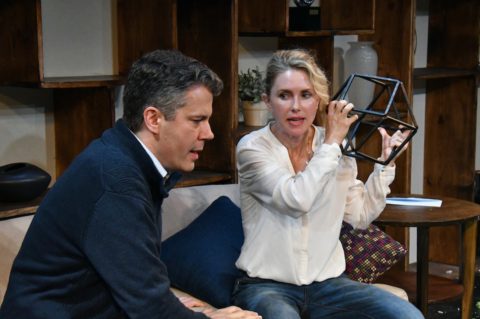 Get ready for a barnburner. “The Goat, or Who Is Sylvia?,” now singeing audience eyebrows at the Custom Made Theatre, is the late Edward Albee’s most uproarious, in-your-face play by a long shot.
Get ready for a barnburner. “The Goat, or Who Is Sylvia?,” now singeing audience eyebrows at the Custom Made Theatre, is the late Edward Albee’s most uproarious, in-your-face play by a long shot.
Sylvia is the non-metaphoric goat. Martin (Matt Weimer) is the architect who’s entangled with her, emotionally and sexually. Stevie (Hilary Hesse) is Martin’s wife. What Mrs. O’Leary’s cow did for Chicago, Sylvia does for domestic bliss.
Though Albee’s best-known works, including “Who’s Afraid of Virginia Woolf?,” “A Delicate Balance” and “The Zoo Story,” offer some immediate rewards to audiences, they tend to grow richer in retrospect. They’re seeded with cryptic subtexts about the mysteries of sexuality, the limits of language and the tricks of memory. Mulling over these plays helps them take root in the mind; they’re acrid-black onions that yield layer upon layer of poetry. Instead of rewarding cool contemplation, “The Goat, or Who is Sylvia?” pays off with explosive flamethrower heat, almost from the get-go.
Hesse delivers a figuratively and literally smashing performance as Stevie, raging at her mild-mannered spouse’s incomprehensible transgression. After initially assuming that allegations of a farmstand romance are a bizarre prank by the couple’s sanctimonious old friend Ross (Ryan Hayes), she begrudgingly recognizes that milquetoast Martin really does enjoy a spread of goat cheese. At which point her emotional and cognitive dams burst in a prolonged rush of accusations, lamentations and shattered ceramics.
It’s a scenario verging on absurdism, but Hesse plays Stevie with stunning believability. Her pained howls and vicious verbal reprisals against Martin induce winces throughout Custom Made’s intimate 99-seat auditorium. It feels dangerous to be in the room with her.
Albee has given Stevie not only the best, bitterest wisecracks — What’s wrong with me, she wonders, “I have only two breasts? I use the toilet?” — but also the play’s one truly profound insight: Almost as an aside, Stevie acknowledges that all members of longterm couples must willingly carry the consciousness of potential tragedy, from emotional disengagement to cognitive failure brought on by stroke, to a partner’s early death.
But even the playwright seems to believe that extramarital “goat-fucking” (it’s in the script) goes beyond that particular pale. Albee never suggests that Stevie has a reasonable burden to bear here. There’s little question that her actions — or at least her emotions — are justified.
It’s much tougher for audience members to empathize with a man in love with an ungulate than with his cuckolded spouse, but Matt Weimar plays Martin with a touching air of disorientation. Floating into fugues of ruminant romance, he shrinks helplessly away from social convention, aswim in an oversized suit (smart work by costume designer Lindsey Eifert). And he wrings the right mix of laughs and gasps from Martin’s centerpiece monologue, the schtickiest bit in all of Albee, an account of a bestiality support-group meeting.
As Billy, Martin and Stevie’s gay teenage son, Max Seijas does decent goggle-eyed disbelief, but the part’s underwritten, primarily here for Albee to provoke passing thoughts about the relative taboos of homosexuality and bestiality. The couple’s old friend Ross is similarly marginal scriptwise, but Ryan Hayes aces the character’s comic sanctimony.
In assuring that his entire cast maintains a clear-eyed, unwinking tone even when their characters turn to dark humor as a coping mechanism, director Paul Stout puts the audience in a state of deliciously unrelenting anxiety. Wincing alternates with nervous laughter as otherwise mundane lives cross paths with the unimaginable.
Make that almost unimaginable. Albee’s real triumph with “The Goat” is to have imagined and seen through on its wild conceit. Yes, the play has some doctorate-level wordplay and a fancypants sub-subtitle — technically, it’s named “The Goat, or Who Is Sylvia? (Notes toward a definition of tragedy).” But those notes, occasional references to classics in the text, aren’t deeply worked through. Albee seems to have made a conscious decision to go big and bold here. The real shocking F-word here is the Fun that this sometimes dour playwright appears to be having.
Where many of Albee’s other plays furrow brows, this one feels written to drop jaws. Instead of sharp-toothed, pseudo-civilized drawing-room comedy, “The Goat,” with its living room set and dramatis personae of Mom, Dad, son and wacky neighbor, plays like a sitcom invaded by a horror movie. As literature, it’s far less subtle and haunting than most of Albee’s work. But as a night out, “The Goat” is a hoot.
Originally published in The Bay Area Reporter
